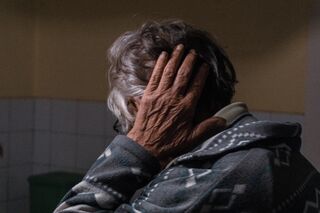Chronic Illness
Can You Make Your Invisible Illness More Visible?
Some chronic illnesses, like migraines, are often invisible to others.
Posted October 30, 2022 Reviewed by Tyler Woods
Key points
- So many people are unaware of the invisible symptoms and impact from chronic illnesses like migraines.
- College students are turning to online learning as one way to cope with the reluctance of facing those who don't understand.
- Let's find ways of developing awareness in ourselves and others for those living with invisible illnesses.

I manage to walk into our local grocery store from a “normal” parking spot, lugging my bags for all that’s on my list and just praying the aisles are not filled with loud people, those who take up most of the aisle, or long lines at the register, as I’m a little less patient than I might be on a non-migraine day. As I come through the doors, though, I realize I am going to experience a rough ride, even with my short list.
The music seems so much louder, the lights brighter, and the crowds greater. Also, the smells from the bath and body section overpower me. Should I leave? How can I, since our dinner depends on my stop? I persevere, hoping I’ll adjust to some, if not all of it. Unfortunately, I know from experience that these problems will just pile on one another, and the relative impatience I entered with will elevate to rage, as the warning signs turn into the beginnings of a migraine attack.
The candles, the repetitious, senseless music, the shouting between aisles, the crowds—all leave me impatient far beyond where they would were I not facing a serious attack.
Nonetheless, by now, I know the signs and try to be patient with myself and others as I face the cashier. I don’t want to take out my pain and all that comes with it on her. Unfortunately, though, she is very deliberate, has a lot of questions regarding the fruit and produce, and isn’t sure how to bag my purchases. I take a deep breath and wonder why there isn’t a special parking spot for people with invisible, chronic illnesses, as there are for parents with small children, the handicapped, pregnant women, and more. I just need to get to the car.
She, of course, has no idea; so many illnesses/disabilities are invisible, yet we continue to look only at what we see visually.
As I considered the list of examples of invisible illnesses offered by the ADA (Americans with Disabilities Act), I realize I suffer from or have lived with several, the most debilitating being chronic migraines. I struggled with endometriosis for many years at a time little was known about it. Eventually, in my 30s, I had a complete hysterectomy.
Because of the endometriosis, I developed Irritable Bowel Syndrome and have been enduring that for over 30 years. Only a year ago, I was diagnosed with POTS (Postural Orthostatic Tachycardia Syndrome), a condition that causes me to pass out, leading to a broken back and stitches after two of my falls.
I mention these conditions because many who know me have no idea that I cope with them. Frequently, symptoms are misunderstood. While a migraine sufferer privately experiences cognitive problems, many people often interpret such behavior as “spacey.” Joan Didion’s seminal essay, "In Bed," which begins So Much More than a Headache: Understanding Migraine through Literature, poignantly captures the cognitive dimension:
“I will drive through red lights, lose the house keys, spill whatever I am holding, lose the ability to focus my eyes or frame coherent sentences, and generally give the appearance of being on drugs, or drunk. The actual headache, when it comes, brings with it chills, sweating, nausea, a debility that seems to stretch the very limits of endurance. That no one dies of migraine seems, to someone deep into an attack, an ambiguous blessing" (Didion 67).
These experiences are one reason why we need more awareness.
The Invisible Disabilities Association (IDA) began hosting Invisible Disabilities Week (IDW) in 2014. Jess Stainbrook, the executive director and vice president, says the week highlights the work the association does year-round, including spreading awareness, creating educational programming, and working to pass legislation for those living with any disability: “But in particular, we highlight the people with invisible disabilities because…people don’t believe them sometimes because they can’t see their condition,” she says.
According to the Association’s website, “People often ask us to define invisible disability… In simple terms, an invisible disability is a physical, mental, or neurological condition that is not visible from the outside, yet can limit or challenge a person’s movements, senses, or activities. Unfortunately, the very fact that these symptoms are invisible can lead to misunderstandings, false perceptions, and judgments” ( IDA).
Some illnesses include:
- Allergies and food intolerances
- Arthritis, especially rheumatoid
- Cancer
- Chronic Fatigue Syndrome
- Fibromyalgia
- Depression and mental illness
- Diabetes
- Digestive disorders such as Celiac, colitis, and irritable bowel syndrome (IBS)
- Endometriosis
- POTS
- Migraine and headache sufferers
- Heart conditions
- Lupus
- Lyme Disease
- Multiple Sclerosis
- Infertility
- Sjogren’s Syndrome
The IDA suggests, “The frustration, weariness, and progressive silence and isolation so many with migraines share often leave the sufferer alone with the pain of the headache and the many other invisible symptoms of the disease—the sudden mood changes (crying, irritability, loss of temper), confusion, memory problems, sudden blanks in thought or word choice, clumsiness, uncontrollable yawning, nausea, dizziness, heightened senses, and overwhelming fatigue” (67).
Unfortunately, stigma often derives from issues of legitimacy regarding these disease symptoms, because some might not be discernible to others. When symptoms cannot be seen, relatives, friends, employers, and colleagues are unlikely to understand the seriousness of the illness and how it impacts the life of the person.
Women are known to be affected by invisible chronic illness at higher rates than men and constantly face judgment and questioning about whether their illness is legitimate or imaginary. Once individuals decide to disclose their chronic illness to those outside of their family, they are often not believed by others, and some individuals have reported people accusing them of faking or making up their illness to avoid obligations or gain special advantages. A lack of disclosure and efforts to conceal their disability status often result in increased anxiety within this population, which can, in turn, exacerbate chronic illness symptoms (Vickers).
This problem has become a distinct issue in higher education, as well, where students are taking online courses more often to avoid dealing with the symptoms in front of others and often having to cope with the responses from other students and their professors, who may not understand their illness.
In the findings of a recent survey, 60 percent of participants reported that they have felt pressured to take online courses due to their illness. A significant percentage of the respondents reported that they had not registered with the Department of Social Services (DSS). One possible reason for this finding is that students may not realize they qualify for accommodations because of their chronic illness.
Another possibility is that students are fearful of discrimination and the potential stigma that comes with registering with DSS, as this study revealed that fear of discrimination and stigma was prevalent among respondents who were living with an invisible illness. Understanding how invisible chronic illness impacts these students should be important to universities because this population is increasing.
Encouraging disclosure means raising disability awareness and fostering positive attitudes toward disability. Fostering an environment that provides students with invisible chronic illnesses to meet other students in similar situations can provide “a sense of validation of your physical condition, of your emotions and perhaps some relief from isolation" (Barber and Williams).
Meghan O’Rourke, the author of the book The Invisible Kingdom: Reimagining Chronic Illness, explains, “The invisibility of my illness was really hard, and writing has helped me process that. I experienced two challenges: the challenge of living with the symptoms, and the challenge of not being seen and heard. The latter is what almost killed me” (O’Rourke).
There are some ways we can help ourselves:
- Be grateful for the supportive family, friends, and medical professionals you do have
- Search for joy in the “moments”
- Focus on the things, people, and passions that give you comfort, satisfaction, and pleasure
Remember, too, to be more patient with and develop more empathy for others, because you know better than most that they, too, could be suffering from an invisible illness.
References
Barber, Danielle and James L. Williams. Journal of Postsecondary Education and Disability, 2021, “Invisible Chronic Illness in Female College Students.” 2021. 34(4), 311-330.
Didion, Joan. "in Bed." So Much More than a Headache: Understanding Migraine through Literature, Ed. by Kathy O'Shea. Kent State University Press, 2020.
O’Rourke Meghan, “What it’s Like to Live with an Invisible Illness.” Healthcare. June 2022.
https://www.aspeninstitute.org/blog-posts/what-its-like-to-live-with-an…
Vickers, M. H. (2017). “Sick organizations, rabid managerialism: Work-life narratives from people with invisible chronic illness”. Public Voices, 4, (59-82.).
Witmer, Psy.D. “Coping with an Invisible Illness” Wtherapy. March 2020. https://withtherapy.com/therapist-insights/coping-with-an-invisible-ill….




